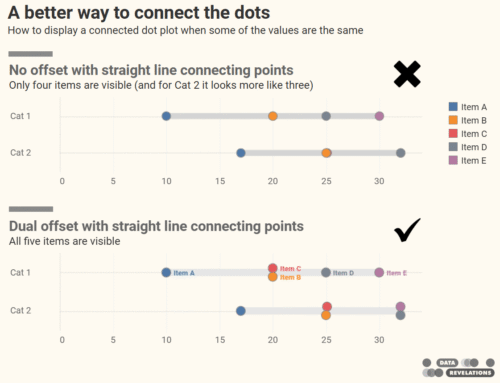September 29, 2019
Overview
1,359 people participated in the 2019 The Annual Data Visualization Community Survey conducted by The Data Visualization Society (DVS). The survey covers professional data visualization details like salary and hourly compensation, tool use, location, demographic data, audiences, organizational structure, and more.
I think this is an ambitious, bordering on heroic, attempt by DVS to understand the habits, proclivities, trials, and triumphs of data visualization professionals. While a wonderful effort, I do not think this is necessarily indicative of the entire industry as the data gathering appears haphazard. Who was this survey sent to? Who completed it? Did anyone try to “game” the system?
I did my best to analyze the data that looked credible and chose not to visualize, and thereby give credibility, to data that I thought was suspect. Don’t worry. Even without this data there’s a lot of great stuff to chew on and I tip my hat to the society for taking on this project.
A deep thanks to Michael Davis for his invaluable assistance in getting the source data in a place where I could work with it, and to Michael, Jeffrey Shaffer, Kevin Flerlage, Anna Foard, and Andy Cotgreave for their feedback.
Also, a thanks to Ash Shih, as I “borrowed” his drop shadow technique for the table of contents page.
The Dashboards
All the dashboards allow you to breakdown and filter by multiple categories, including gender identity, level of education, type of organization, relationship with stakeholders, and so on.
** Click here to explore, or read what follows for some highlights. **
Check All That Apply Questions
I grouped all the questions asking people what tools they use, what types of presentations they create, what methods for teaching they recommend, etc., into two related dashboards, one that shows a gap analysis among respondents and the other that shows rank, magnitude, and margin of error.
For a discussion of margin of error and showing confidence levels, click here.
Finding # 1 – Men use scatterplots more often than women
76% of men indicated they’ve used a scatterplot in the past six months vs. 63% of women.
(Note that if you hover over a color-coded bar on the right, all the mark labels appear for that color. You can also hover over a dot to see its value).

Figure 1– Gap chart showing which chart types respondents use.
Finding # 2 – PhDs use pie charts considerably less often than other people (but they really like scatterplots).
Only 26% of PhDs use pie charts vs. 41% overall, but 81% use scatterplots vs. 71% overall.

Figure 2 — Gap chart showing breakdown by level of education.
Note that if you hover over the PhD bar it’s easier to see the values.

Figure 2a — Hovering makes it easier to focus on a segment.
Here’s another take on the same question and the same breakdown, but here we see rank, magnitude, and margin of error (confidence level of 95%).

Figure 3 — Showing overall rank and rank and magnitude broken down by level of education.
Pies charts are ranked fourth overall but ninth for PhDs.
Note that as the number of respondents in a category decreases, the margin of error increases.
Finding #3 – Tableau is very popular, at least among those who took the survey
Here are the results for the question “What technologies do you use to visualize data?”

Figure 4 — What technologies do respondents use?
Excel comes in at number one, followed by Tableau and then R. This is one of several questions that had me thinking “who took this survey?”
It may be that this is an amazingly accurate reflection of the entire data visualization, but we do NOT know that for sure and to state otherwise would be deceitful. Indeed, we don’t even know if this is an accurate reflection of just the 3,000+ Data Visualization Society members, as this survey was circulated through social media.
But… it is certainly an accurate reflection of the 1,359 people who did take the survey, and there are some fascinating findings around tool usage, like this next one.
Finding # 4 – Journalists use different tools
At least these 70 who responded to the survey use different tools than people who work in other types of organizations.

Figure 5 — Technology usage, broken down by organization type.
If you’re considering a career in data journalism – and if the responses from these 70 people are an accurate reflection of the industry – be prepared to use D3, Illustrator, Pen & Paper, QGIS and maybe Canvas.
Finding # 5 – Women like workshops more than men
So, I present workshops, and I am curious about what methods people think best teach data visualization.

Figure 6 — Methods to teach data visualization, broken down by gender
53% for women and 36% for men think workshops are a good teaching method.
I have some theories about the large gap, and I suspect it may have to do with who participated in the survey.
Sorry, I’m not going to share that theory here.
Single select questions
I grouped all questions where people could only select a single answer into an interactive dashboard.
Finding # 6 – Newbies plan to focus on both data skills and design skills
Here is the result for the question “What are is your next priority for improving data visualization skills?” broken down by years in data visualization.

Figure 7 — Priorities for improvement.
Design skills is number 1 overall (and happens to be very high among PhDs, in case you were curious) while improving data skills is ranked fourth with about half as many respondents.
But when you just look at those who are new to data visualization, design and data skills are roughly the same (24% and 23% respectively).
Finding # 7 – Those in a subordinate position cannot choose their own tools as readily as others
And that can cause problems
Respondents were asked to characterize their relationship with stakeholders and select one of three options (collaborative, consultative, and subordinate). My hats off to whomever came up with this question as it shines some interesting light on a bunch of other questions, including the one I explore here.
There’s a big difference among these groups when we asked people about freedom to choose their own tools.

Figure 8 — Ability to select tools broken down by stakeholder relationship
Agree or disagree questions (Likert scale questions)
There were five questions that asked the degree to which people agreed or disagreed with various statements. Four of the questions used a 5-point Likert scale and one of the questions used a 7-point scale.
To whomever threw in that 7-point question: I’d like two hours of my life back, please (mutter, mutter, grumble).
I chose to show overall positive, negative, and neutral sentiment like this.

Figure 9 — The degree to which people agree, disagree, or are neutral for five statements
If you want to see the degree to which people agree or disagree you can hover over any of the bars.

Figure 10 — Hovering over a bar provides additional details.
If you are curious about different approaches to displaying sentiment and proclivities, please see Rethinking the divergent stacked bar chart.
If you select a statement you can see how different populations responded. This is where things get interesting.
Finding # 8 – With respect to having adequate resources, there’s big difference when we cut the data by gender and stakeholder relationship.

Figure 11 — Adequate resources, broken down by gender.
Here, 64% of men indicate they have adequate resources compared with only 50% for women.
Here’s the breakdown by Stakeholder relationship.

Figure 12 — Adequate resources, broken down by stakeholder relationship.
Finding # 9 – Does leadership get it?
If you’ve been in data visualization for a long time, you think yes. If you are in a subordinate role, you think no.
Here’s the responses to the statement “Leadership in your organization has a strong understanding of the value of data visualization” broken down by the number of years a respondent has been in data visualization.

Figure 13 — Feelings about leadership, broken down by years of experience.
Here’s the same statement, broken down by stakeholder relationship.

Figure 14 — Feelings about leadership, broken down by stakeholder relationship.
Benchmarking questions
I decided to tackle the question asking people their hourly rate.
Here are the overall results.

Figure 15 — Hourly rate for 453 people that responded to this question.
Notice that only 453 people answered this question. I first thought that those that did respond are freelancers, but when we breakdown by freelancer status we see that only half the respondents indicated “Yes / Occasional”.

Figure 16 — Hourly rate broken down by freelancer status.
I interpret this to mean that for those that indicated “yes”, this is what they charge. For those that said “no”, this is the fee their company charges for their services.
Finding # 10 – The median hourly rate men charge is much higher than women
The median rate for men is $60 an hour vs. $44 for women.

Figure 17 — Hourly rate broken down by gender.
Some fun things to try
If you hover over a dot you will see details about the respondent.

Figure 18 — Exploring an individual response.
If you select the dot, you can explore results for people with a similar background. For example, this is what happens if you select “10 or more years”.

Figure 19 — Seeing responses from others with similar characteristics.
A few final thoughts on the survey
You can see how the survey was presented in the wild by clicking here.
With respect to gender identity, there were more answers than just men and women. Here is a summary of the raw responses.

Figure 20 — Gender identity raw responses
I’ve included responses from everyone who took the survey results, but when breaking down by gender I just show men and women. If you explore the Gender filter you will see other choices.
I came close to visualizing the number of hours per week worked on various data visualization endeavors but didn’t have enough confidence in the data. For one thing, several people indicated that they work more than 190 a week on data visualization. This is very impressive… and impossible.
Here are the findings with some of the more questionable responses removed.
 Figure 21 — The hours per week respondents spend on various data visualization activities.
Figure 21 — The hours per week respondents spend on various data visualization activities.
Should the Data Visualization Society run another survey next year (and I hope they do) I would encourage them to consider first asking how many hours per people work on data visualization overall, and then ask people to indicate the percentage they spend on the five activities. I think this will yield better results.
Click here to explore the interactive dashboards.






